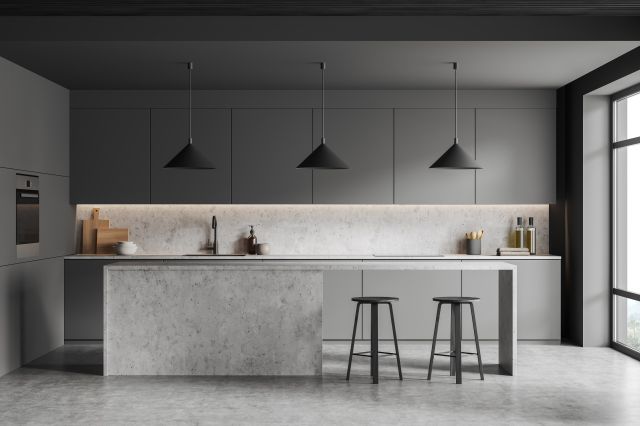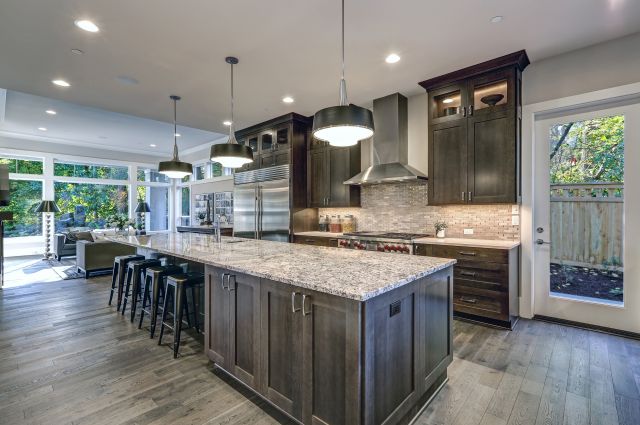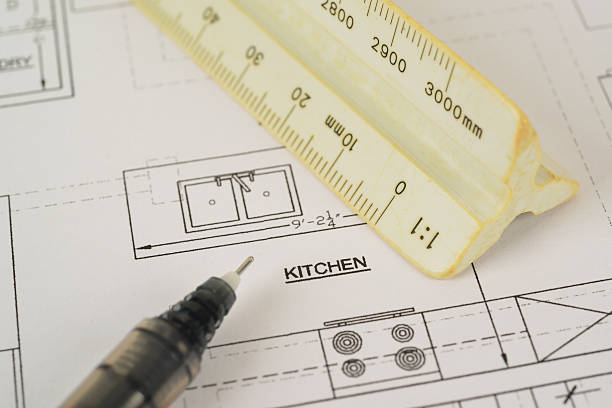When it comes to kitchen remodeling or designing from scratch, understanding and implementing the right measurements can enhance both the functionality and aesthetics of your space. One crucial aspect to consider is the “countertop overhang.” But how much overhang for the countertop do we actually need?
What is Countertop Overhang
Countertop overhang refers to that portion of your kitchen floor or countertop that extends past the front edge of your cabinets to accommodate bar stools or islands underneath. Apart from enhancing the visual appeal, a standard countertop overhang protects the cabinets that accommodate bar stools below by preventing spills and crumbs from falling directly onto them.
It also provides additional space between drawers and cabinets to accommodate the bar stools from under kitchen islands or bar tops.

Considerations for Deciding on Countertop Overhang
The choice of material for the right overhang of your countertop can significantly influence the standard countertop overhang top’s size and need (Learn: 8 Main Types of Countertops You Need to know before Buying) for additional support. The strength, flexibility, and weight of the standard countertop overhang material would affect how much it can overhang without the risk of breakage or sagging. Here are a few considerations:
- The Material’s Strength and Durability Countertops made from strong and durable materials like granite, : (Learn: Get Creative With Granite Alternatives for Countertops) quartz, and concrete can typically handle larger overhangs without requiring additional support. These materials are resistant to breakage and able to support their weight effectively.
- The Material’s Flexibility: Some materials, like solid surface countertops, (Learn: How To Cut Solid Surface Countertops) have a degree of flexibility that allows for a larger overhang. This flexibility means the countertop can resist bending or snapping under less weight or pressure.
- The Material’s Weight: Heavy materials such as granite or concrete require strong supports if the overhang extends past the standard recommendation. In contrast, lighter materials like laminate or solid surfaces may be able to extend further without needing extra supporting structures.
- Thickness of the Countertop: Thicker countertops may typically handle a larger overhang before needing support compared to thinner ones. The extra thickness can provide added strength to the countertop.
- Texture and Pattern of the Material: Some materials like marble or certain types of granite have veins or patterns. If the countertop overhang is too long, these patterns might visually dip or sag and may appear unattractive.
- Maintenance and Longevity: Some materials may require frequent sealing or have a shorter lifespan. Extending the maximum overhang amount beyond the most standard overhang size might expose these materials to more potential damage, affecting their lifespan and looks.
Standard Measurements of Countertop Overhang
Various countertop sections and types necessitate different side overhang measurements and dimensions. Some of the most common are:
| Types of Countertops | Standard Dimensions |
| Standard Kitchen Countertops | 1-1/4 to 1-1/2 inches |
| Kitchen Islands | 12 inches |
| Raised Bar Tops | 12 inches |
| Seating Areas | 15-18 inches |
| Against Appliance | 1/4 to 1/8 inch |
| Against Wall | no overhang |
Standard Kitchen Countertops
This term typically refers to countertops along the wall with base cabinets underneath. The standard countertop and base cabinets overhang for these countertops and base cabinets is 1-1/4 to 1-1/2 inches past the face of the base cabinets below.
Kitchen Islands
Kitchen islands often include seating, leading to a greater overhang requirement than standard countertops. The standard overhang measurement for kitchen island countertops with seating is typically 12 inches, although custom-builts can vary.

Raised Bar Tops
Often requiring barstools for seating, raised bars have a height of around 42 to 48 inches. Similar to kitchen islands, the common overhang for these countertops is 12 inches.
Seating Areas
For seating areas at standard countertop height, overhangs usually range from 15 to 18 inches. This length ensures comfortable leg space for people seated at the counter.
Against an Appliance
Where countertops abut appliances, the overhang should be approximately 1/4 to 1/8 inch.
Against a Wall
When countertops meet walls, on the sides, or in the back, there’s typically no overhang to avoid creating a slit that would collect dust and debris. Each of these kitchen countertop side sections or types serves varying purposes and hence commits to different sizing guidelines for overhangs.
Still, it’s crucial to take your specific kitchen countertop’s functionality and aesthetics into account when determining the exact dimensions.

Factors That Influence Countertop Overhang
Aesthetics
The design professionals desired aesthetic appearance plays a significant role most homeowners have in determining the maximum overhang amount of a countertop. Some people prefer a sleek and minimalistic look with a minimal overhang, while others may have less space and opt for a more prominent overhang to create a statement or accommodate seating areas.
Functionality
The intended use of the countertop also influences the overhang. For countertop seating, a greater overhang is required because the user’s legs are bent when seated.
alt: countertop seating
Support
The amount and type of extra support available for a leading edge on the countertop will impact the overhang. Overhangs exceeding 12 inches typically require additional support for the leading edge, such as brackets or corbels, to ensure stability and prevent countertop material sagging.
Material and Thickness
The material and thickness of the countertop can affect the overhang as well. Compared to others, like laminate, some materials, such as granite materials or quartz materials, are more durable and can support larger overhangs. Thicker countertops can also provide more stability and support for longer overhangs.
Building Codes
Local building codes and regulations may have specific requirements for countertop overhangs to ensure safety and compliance. It is essential to consult with a professional or check local codes to determine any restrictions or guidelines.
Determine the Amount of Countertop Overhang Required
Determining the amount of countertop overhang required involves a careful analysis of several crucial aspects. Here’s how you can go about it:
- Understand the Purpose: Identify the primary purpose of your countertop space. If you’re using it mainly for food preparation, a standard overhang of about 1 to 1.5 inches is typically sufficient. However, if you plan to include seating around the countertop, such as on a kitchen island, you’d need a more substantial overhang. The standard for this is typically 12 inches, but it may be more depending on your stools’ height and comfort requirements.
- Evaluate Your Kitchen Size and Layout: The size and layout can heavily influence the overhang required. If your kitchen is compact, a larger overhang may make the space feel cramped or affect movement around the kitchen. However, in a generously spaced kitchen, a lesser overhang would look out of proportion, and a larger overhang might enhance the functionality and visual appeal.

- Take Material and Thickness into Account: Some materials like granite and quartz are more robust and can handle a larger overhang without additional support. On the other hand, materials like marble might require support for anything beyond the standard dimension. The thickness of the countertop can also influence the amount of overhang—thicker countertops typically can support a larger overhang.
- Consider the Potential Need for Support: If you choose a larger overhang for your countertops, keep in mind that you might need additional support structures such as corbels or brackets to ensure the countertop’s stability and prevent sagging or breaking.
- Check Professional Standards: Countertop manufacturers and kitchen designers have standard recommendations for countertop overhangs based on their extensive experience. Consulting with these professionals or their guidelines can be beneficial.
- Factor in Your Personal Preferences and Comfort: Ultimately, your comfort matters the most. Customize the overhang to suit your needs perfectly—it should enhance your efficiency while working in the kitchen and look aesthetically pleasing.
Remember, each kitchen island countertop is unique, so determining the amount of kitchen island countertop overhang required for kitchen space may vary from case to case. Getting it right will improve both the functionality kitchen island countertop and the visual appeal of your kitchen.
Methods to Measure Countertop Overhang
Measuring kitchen countertop overhang is straightforward with the right tools and methods. Here are the steps to take the right and different overhang measurements for regular countertops:
- Gather Your Tools: You’ll need a straight ruler or a tape measure for this task.
- Position Yourself Properly: To get an accurate measurement, it is crucial to stand directly over the countertop. This will give you a clear view of both the edge of the countertop and the edge of the base cabinet or island below.
- Align the Ruler: Align your ruler or tape measure directly with the edge of the countertop. It is generally best to start from the 1-inch mark of the measure to ensure precision measurement.
- Measure the Overhang: Extend the tape measure or ruler out over the edge of the cabinet or island. Look straight down to where the countertop edge aligns with a measurement on your ruler or tape measure. The distance from the tape measure’s 1-inch mark to the countertop edge gives you the size of the overhang.
Remember, consistency in the different overhang measurements is key, especially if you are measuring and planning standard countertops and island overhang measurements, and measurement multiple sections need to match.
Repeat the aforementioned steps for standard and island overhang measurements in all areas where you need to measure the island countertop and standard overhang measurement.
Conclusion
Understanding how much countertop overhang is needed for your kitchen—whether it’s for food prep or dining purposes, remains a vital part of effective kitchen design and planning. It not only provides function but affects the overall aesthetics of the kitchen.
So, next time you plan a kitchen remodel, remember the importance of determining a suitable countertop overhang. It’s more than just a detail; it’s an integral part of a well-planned, functional, and beautiful kitchen.
With more additional supporting information, there may be enough room for more overhangs than you think. Contact KKR for more information on selecting the perfect kitchen island and counters.



